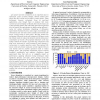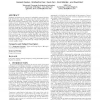96 search results - page 5 / 20 » Energy and Performance Improvements in Microprocessor Design... |
IPCCC
2006
IEEE
14 years 1 months ago
2006
IEEE
Low power has been considered as an important issue in instruction cache (I-cache) designs. Several studies have shown that the I-cache can be tuned to reduce power. These techniq...
ASPLOS
2008
ACM
13 years 9 months ago
2008
ACM
Integrating more processor cores on-die has become the unanimous trend in the microprocessor industry. Most of the current research thrusts using chip multiprocessors (CMPs) as th...
DAC
2008
ACM
14 years 8 months ago
2008
ACM
Hardware accelerators are common in embedded systems that have high performance requirements but must still operate within stringent energy constraints. To facilitate short time-t...
DATE
2009
IEEE
14 years 2 months ago
2009
IEEE
Abstract—To deal with the “memory wall” problem, microprocessors include large secondary on-chip caches. But as these caches enlarge, they originate a new latency gap between...
MICRO
2002
IEEE
13 years 7 months ago
2002
IEEE
On-chip caches represent a sizeable fraction of the total power consumption of microprocessors. Although large caches can significantly improve performance, they have the potentia...


